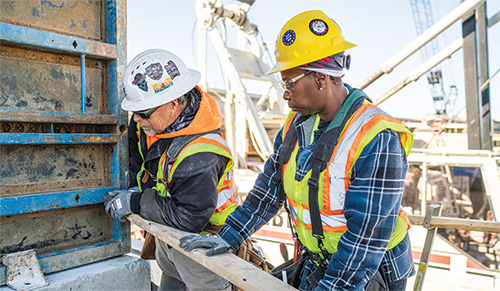Illinois’ construction apprenticeship programs rival state colleges and universities
 La Grange, IL – From the number of training hours and graduation rates, to the diversity of classes and the lifetime earnings of graduates, Illinois’ joint-Labor management construction apprenticeship programs are rivaling – and in some cases exceeding– the performance of the state’s colleges and universities, according to a new study from the Illinois Economic Policy Institute (ILEPI) and the Project for Middle Class Renewal (PMCR) at the University of Illinois at Urbana-Champaign.
La Grange, IL – From the number of training hours and graduation rates, to the diversity of classes and the lifetime earnings of graduates, Illinois’ joint-Labor management construction apprenticeship programs are rivaling – and in some cases exceeding– the performance of the state’s colleges and universities, according to a new study from the Illinois Economic Policy Institute (ILEPI) and the Project for Middle Class Renewal (PMCR) at the University of Illinois at Urbana-Champaign.
“Every year, thousands of Illinois residents enroll in apprenticeship programs as a tuition-free alternative to college,” said study co-author and ILEPI Policy Director Frank Manzo IV. “Including up to six years of classroom instruction and on the job training, these programs play a vital role in producing workers with in-demand skills for today’s economy, and give participants the extraordinary opportunity to earn while they learn.”
MORE THAN 85% IN THE CONSTRUCTION SECTOR
More than 85 percent of all apprenticeship enrollment in Illinois is in the construction sector, making the industry’s apprenticeship system one of the state’s largest privately-financed post-secondary institutions.
Of those apprentices, 97 percent are enrolled in programs administered jointly by unions and their signatory contractors (“joint Labor-Management programs”), and fully funded by privately negotiated cents-per-hour contributions from employers.
“Joint Labor-Management apprenticeships are clearly the best-in-class model, and are far outperforming employer-only programs on every available measure,” said study co-author and PMCR Director Dr. Robert Bruno. “In fact, the data shows that joint construction programs are delivering a more robust training regimen than other post-secondary institutions, and equal or greater lifetime earnings for their graduates.”
GRADUATES REFLECT STATE’S RACIAL DIVERSITY
The total number of active apprentices in Illinois has grown by 34 percent since 2011. While most apprenticeships are concentrated in historically male-dominated industries, such as construction, manufacturing, transportation, and wholesale trade, the U.S. Department of Labor data shows that graduates are increasingly reflecting the racial diversity of Illinois as a whole.
In 2017, joint construction programs graduated a share of African Americans and Latinx participants (nine percent and 11 percent respectively) that was on par with the state’s public universities (10 percent and 12 percent respectively) — and graduated a greater share of African Americans than the state’s private non-profit universities.
Joint construction programs have also had significantly higher completion rates for African Americans, Latinx participants, women, and military veterans than employer-only construction programs.
“The state’s largest joint Labor-Management apprenticeship programs are helping more Illinois workers access ladders to the middle class– particularly from historically underserved communities,” Manzo added. “With many industries still reporting labor shortages, policymakers should work to extend these programs to more in-demand occupations, and address stigmas and other barriers that can discourage workers from pursuing vocational training.”
Manzo and Bruno say that should include expanded development of pre-apprenticeship coursework at public high schools and community colleges, expanded access to child care to boost female participation in apprenticeships, and promotion of a new state tax credit for businesses that invest in apprenticeship training.



Leave a Reply